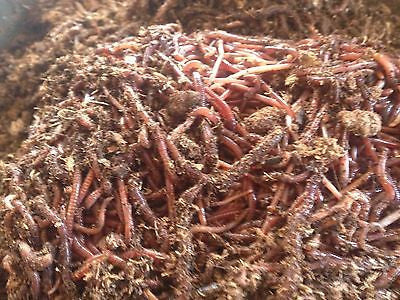Live red wigglers: Make composting fun
The Ultimate Overview to Red Wigglers for Healthy And Balanced Soil
The function of red wigglers, medically referred to as Eisenia fetida, in soil health is a topic of raising rate of interest amongst sustainable horticulture lovers and farming specialists alike. These microorganisms not just recycle organic waste yet additionally improve dirt fertility via their nutrient-rich castings. Comprehending exactly how to effectively cultivate and utilize these worms can transform your gardening practices. The process of establishing up a conducive atmosphere for these useful creatures and optimizing their contribution to dirt wellness entails numerous essential factors to consider that merit closer assessment. What are the important actions to make sure a flourishing worm populace?
What Are Red Wigglers?
Red wigglers, medically called Eisenia fetida, play a critical duty in composting and dirt health. These earthworms are especially well-suited for vermicomposting, a procedure that uses their natural actions to disintegrate natural matter effectively. Unlike other earthworm species, red wigglers grow in rich organic environments, making them perfect for garden compost containers and worm ranches.
Determining regarding three to 4 inches in size, red wigglers have a distinct reddish-brown pigmentation and a fractional body that helps in their wheelchair via rotting products. They are detritivores, indicating they eat decaying organic materials, including cooking area scraps, plant particles, and paper items. red worms. With their consumption of these products, they aid break down intricate substances, transforming them into nutrient-rich spreadings that improve soil quality
Red wigglers are also prolific breeders, with the ability of duplicating swiftly under ideal conditions. Their versatility to numerous atmospheres enables them to thrive in an array of composting systems. By recognizing the biology and ecological relevance of red wigglers, garden enthusiasts and farmers can harness their capacities to enhance soil health and promote sustainable methods in agriculture.

Advantages of Red Wigglers
The various benefits of incorporating red wigglers right into composting methods dramatically improve dirt health and wellness and fertility. These earthworms, medically referred to as Eisenia fetida, succeed at breaking down raw material, transforming cooking area scraps and yard waste into nutrient-rich vermicompost. This procedure not just increases disintegration but likewise enriches the soil with essential nutrients such as nitrogen, phosphorus, and potassium.
Moreover, red wigglers boost soil framework by developing aggregates that promote oygenation and water retention. Their burrowing tasks promote a well-aerated atmosphere, permitting roots to gain access to oxygen extra efficiently. This improved oygenation also promotes beneficial microbial task, which is crucial for nutrition biking and overall soil vitality.
In addition to boosting dirt make-up and structure, red wigglers contribute to pest monitoring. Their presence in the soil assists subdue harmful nematodes and other bugs, minimizing the requirement for chemical interventions. The application of vermicompost leads to enhanced plant durability against diseases, promoting healthier growth.
Establishing Up a Worm Container
Establishing up a worm container can be a rewarding venture for those seeking to boost their composting initiatives. The primary step is choosing a suitable container, ideally made of plastic or wood, with a capacity of at the very least 10 gallons to suit the worms and their food. Make certain the container has adequate ventilation-- pierce tiny openings in the lid and sides to promote airflow while avoiding excess dampness accumulation.

Introduce the red wigglers right into the bin, enabling them to adjust to their brand-new atmosphere. Ideally, begin with a populace of concerning one extra pound of worms per square foot of surface area. Ultimately, put the worm bin in a location that keeps a steady temperature level, ideally between 55 ° F and 77 ° F. With these fundamental steps, your worm container will be all set to flourish in the search of healthy and balanced dirt.
(redworms for composting)
Feeding Your Red Wigglers
When it comes to nurturing red wigglers, understanding their dietary requirements is essential for maintaining a healthy and balanced worm bin. These worms flourish on a varied diet regimen, primarily made up of organic matter.
Portion control is essential; overfeeding can lead to odor problems and bring in insects. A good general rule is to use food that is approximately equivalent to the weight of the worms in the bin every week. Display the intake price and change feeding amounts appropriately.
To advertise a well balanced diet plan, aim to give a mix of nitrogen-rich environment-friendlies, such as veggie peels, and carbon-rich browns, such as dried leaves or cardboard. Additionally, preserving proper moisture degrees is important-- food scraps must be wet however not soggy - red worms. By very carefully managing their diet plan and atmosphere, you will make sure that your red wigglers stay healthy and productive, adding properly to the composting process
Using Worm Spreadings in Dirt
Including worm spreadings into soil can dramatically enhance its wellness and fertility. Worm castings, also called vermicompost, are an abundant resource of nutrients, consisting of nitrogen, phosphorus, and potassium, important for plant development. When included to soil, these castings improve its structure by boosting oygenation and boosting dampness retention, which is specifically beneficial in arid areas.
Additionally, worm spreadings present helpful microbes that promote a healthy soil ecosystem (red worms). These bacteria help in damaging down raw material, making nutrients much more easily offered this contact form to plants. The existence of these microorganisms also helps suppress soil-borne conditions, minimizing the requirement for chemical plant foods and chemicals
To utilize worm spreadings properly, blend them right into the leading few inches of soil before growing or apply them as a top clothing around developed plants. A recommended application price is concerning 10-20% spreadings blended with soil to enhance nutrient schedule without frustrating the plants.
Final Thought
In final thought, red wigglers, or Eisenia fetida, play a critical duty in improving dirt health and wellness through their vermicomposting tasks. Ultimately, the integration of red wigglers right into dirt management strategies advertises lasting agriculture by reducing dependency on chemical fertilizers and cultivating useful microbial task.